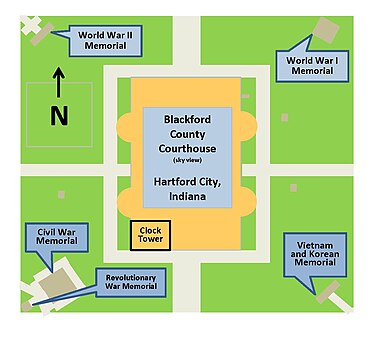
Blackford County is located in the east central portion of the U.S. state of Indiana. The county is named for Judge Isaac Blackford, who was the first speaker of the Indiana General Assembly and a long-time chief justice of the Indiana Supreme Court. Created in 1838, Blackford County is divided into four townships, and its county seat is Hartford City. Two incorporated cities and one incorporated town are located within the county. The county is also the site of numerous unincorporated communities and ghost towns. Occupying only 165.58 square miles (428.9 km2), Blackford County is the fourth smallest county in Indiana. As of the 2020 census, the county's population was 12,112. Based on population, the county is the 8th smallest county of the 92 in Indiana. Although no interstate highways are located in Blackford County, three Indiana state roads cross the county, and an additional state road is located along the county's southeast border. The county has two railroad lines. A north–south route crosses the county, and intersects with a second railroad line that connects Hartford City with communities to the west.

Hartford City is a city in the U.S. state of Indiana, and the county seat of Blackford County. Located in the northeast central portion of the state, the small farming community underwent a dramatic 15-year economic boom beginning in the late 1880s. The Indiana Gas Boom resulted from the discovery and exploitation of natural gas in the area. The rural economy was transformed to one that included manufacturing. The boom attracted workers and residents, retail establishments, and craftspeople. The increased population was a catalyst for the construction of roads, schools, and churches. After the boom came a long period of growth and stability. Agriculture remained as the basis for the economy.

Montpelier is a city in Harrison Township, Blackford County, in the U.S. state of Indiana. This small rural community, the county's first to be platted, was established by settlers from Vermont, and is named after Vermont's capital city of Montpelier.
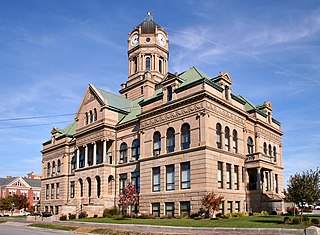
The Auglaize County Courthouse is located between West Mechanic, Willipie, West Pearl and Perry Streets in downtown Wapakoneta, Ohio, United States. Completed in 1894, it is listed on the National Register of Historic Places.

The Fulton County Courthouse, built in 1870, is a historic courthouse building located in Wauseon, Ohio. On May 7, 1973, it was added to the National Register.

The Guernsey County Courthouse is located on U.S. Route 40 in Cambridge, Ohio. The property was listed on the National Register of Historic Places in 1973.

The Geauga County Courthouse is located at 100 Short Court Street in Chardon, Ohio. The cornerstone was laid September 10, 1869 and construction was completed on August 20, 1870. The courthouse was listed on the National Register in 1974 as part of the Chardon Courthouse Square District.
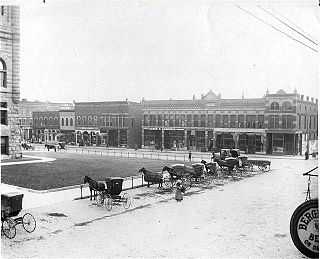
Hartford City, Indiana, began in the late 1830s as a few log cabins clustered near a creek. The community became the county seat of Blackford County. Located in the north east-central portion of the state, the small farming community experienced a 15-year "boom" beginning in the late 1880s caused by the discovery of natural gas. The Indiana Gas Boom caused the community to transition from an agricultural economy to one that also included manufacturing. During the 1890s, Hartford City was the home of the nation's largest window glass company and the nation's largest producer of lantern globes.

The Clark County Courthouse is located at the northwest corner of North Limestone and East Columbia Streets in Springfield, Ohio. The courthouse standing is the third for the county and is built over the foundations of the second.

Edward Everett Cox was an American newspaper publisher who started Blackford County's first daily newspaper in Hartford City, Indiana. He is "considered one of the most influential forces in journalism" in Blackford County, and was a strong supporter of the Democratic Party. Serving as publisher and sometimes as editor of his newspaper, he also spent time as chairman of the eleventh congressional district, county chairman of the Democratic Party, member of the school board, and postmaster. His newspapers were a "voice" for the Democratic Party for nearly 40 years.
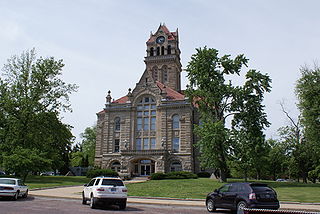
The Starke County Courthouse is a historic courthouse located at Knox, Starke County, Indiana. It was designed by the architectural firm of Wing & Mahurin, of Fort Wayne and built in 1897. It is a three-story, Richardsonian Romanesque style Indiana Oolitic limestone and terra cotta building. It has a Greek cross-plan and is topped by a tiled hipped roof. It features a 138 feet tall clock tower located at the roof's center.
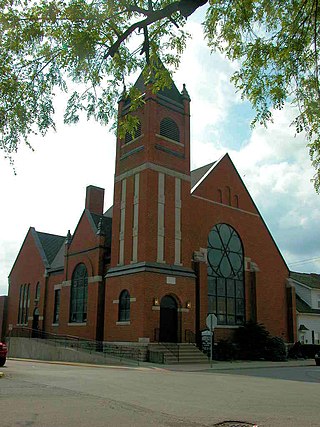
The First Presbyterian Church of Hartford City is a Presbyterian church in Hartford City, Indiana, United States. The edifice is the oldest church building in a small city that at one time was a bustling community with as many as ten glass factories – and over 20 saloons. Located at the corner of High and Franklin Streets, the church is part of the Hartford City Courthouse Square Historic District. The church was added to the National Register of Historic Places in 1986.

The Jasper County Courthouse in Rensselaer, Indiana is a building from 1898. It was listed on the National Register of Historic Places in 1983 and is located in the Rensselaer Courthouse Square Historic District. The Jasper County Courthouse was erected in 1898 at a total cost of $141,731.94. It is located in the center of the Courthouse Square bounded by Washington, Cull en, Harrison and Van Rensselaer Streets. The Courthouse Square, itself, is defined by a retaining wall of concrete, about 18" high and a foot wide. There are steps leading from the street to the walks leading to all four entrances to the building.
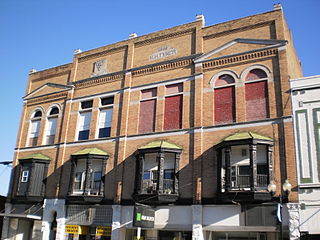
The Hartford City Courthouse Square Historic District is located in Hartford City, Indiana. Hartford City has a population of about 7,000 and is the county seat of Blackford County and the site of the county courthouse. The National Park Service of the United States Department of the Interior added the Hartford City Courthouse Square Historic District to the National Register of Historic Places on June 21, 2006 — meaning the buildings and objects that contribute to the continuity of the district are worthy of preservation because of their historical and architectural significance. The District has over 60 resources, including over 40 contributing buildings, over 10 non-contributing buildings, 1 contributing object, 8 non-contributing objects, and two other buildings that are listed separately in the National Register.

Mollie is an extinct American village in Blackford County, Indiana, that flourished during the Indiana Gas Boom from the 1880s until the 1920s. The region around Mollie experienced an economic "boom" period because of the discovery of gas and crude oil. Mollie was a stop along the Fort Wayne, Cincinnati, and Louisville Railroad—and happened to be near the region's oil fields, a convenient location for the area's oil workers.

This is a timeline and interactive map of Blackford County, Indiana. The timeline (below) lists important events in Blackford County history. An adjacent (right) interactive map contains links to various locations around the county.

Hartford City Glass Company was among the top three window glass manufacturers in the United States between 1890 and 1899, and continued to be one of the nation's largest after its acquisition. It was also the country's largest manufacturer of chipped glass, with capacity double that of its nearest competitor. The company's works was the first of eight glass plants that existed in Hartford City, Indiana during the Indiana Gas Boom. It became the city's largest manufacturer and employer, peaking with 600 employees.

The Jeff Davis County Courthouse is located in the town of Fort Davis, the seat of Jeff Davis County in the U.S. state of Texas. The courthouse was constructed between 1910-1911 and added to the National Register of Historic Places in 2002. The Texas Historical Commission (THC) has also designated the building as a Recorded Texas Historic Landmark since 2000 and, along with the surrounding courthouse square, as a State Antiquities Landmark since 2003. The surrounding county and county seat, along with the nearby historic frontier fort at Fort Davis National Historic Site, are named after Jefferson Davis, who served as U.S. war secretary at the time of the establishment of the fort and the town, and who would later become president of the Confederate States of America during the Civil War.

Taliaferro County Courthouse is a historical government facility and Clock tower located in the city of Crawfordville, Georgia, ninety miles (140 km) east of Atlanta and around fifty miles west of Augusta. Taliaferro County Courthouse is located downtown Crawfordville, Ga. The surrounding buildings are the Health Department, Senior Citizens building, Family Connection Center, and the Georgia Farm Bureau. It has been the official home of Taliaferro's Superior Court, and the base of the county's government, as well as other numerous administrative offices.








